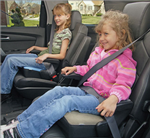The law states that any child up to the age of 3 years MUST use an approriate child restraint. A child over the age of 3 MUST use an appropriate child restraint if it is available.
What is the current car seat law in Jersey?
The law states that any child up to the age of 3 years MUST use an appropriate child restraint. A child over the age of 3 MUST use an appropriate child restraint if it is available.
Click here to take you to Jersey Safe Roads website explaining Jersey’s current child restraint and seat belt legislation.
What does the European law mean?
The E.U. law basically means that any driver could be fined in a European Union country if they fail to ensure any under 12’s travelling in their car are secured using a high-backed booster seat or appropriate car seat for their height and weight.
Whilst this law has not been introduced into Jersey just yet, we strongly recommend that children are put into high-backed booster seats now (if they are under 12 and under the height restriction). Don’t wait until it is too late!
If you still not sure – take a look. Is the seatbelt always cutting across their neck and sits across their tummy? With the correct restraint it should sit across the shoulder and over the hips and lap.
Car Seats?
Manufacturers use different names for their products so the names we have used below may not always apply and are a guide only.
Manufacturers sometimes combine weight ranges in one product so that it can be used over a longer time as a child grows.
When buying a new seat you must take into account both the weight and the age of the child. If you are buying an iSize seat, it is the height and age of the child you should take into account. In rear facing seats if your child’s head is not fully supported and goes above the back of the seat you should consider moving up to the next stage. But if your child is very tall and their legs hang over, that’s fine they can bend their legs!
We and Jersey’s Road Safety Officer recommend keeping your child in a rear facing car seat for as long as possible, giving added protection to their head and neck. We would also recommend high backed booster seats rather than just the base, that give added side impact protection.
- Group 0 and Group 0+. These are baby seats – rear-facing and for children up to 10kg and up to 13kg respectively (aprox age birth to 9-12 months);
- Group I. Child seats – forward facing and for children 9kg to 18kg (approx 9 months to 4 years);
- Group II. Booster seats – for children from 15kg to 25kg (approx 4 to 6 years), or 15kg up to 36 kg);
- Group III. Booster cushions – for children from 22kg and up to 36kg (from approx 6 years).
When buying a new car seat you need to make sure it will fit your car. Not every seat does, and there are serious problems that could happen if the seat does not fit properly.
I have an Isofix carseat system – is fitting different?
A new safety standard for car seats used by children is soon to be the law within the European Union. What does the i-Size Isofix carseats provide?
- Improved protection at higher forces for side &front impact and a much better protection of head and neck
- Rearward faced travelling mandatory up to 15 months old
- i-Size also requires Isofix, which has less chance of being incorrectly used than belted car seats
- i-Size car seats will fit all Isofix cars
- Length classification for easier choosing the right car seat rather than weight, similar to clothing size
What about using a second hand car seat?
If you know the history of the car seat then it’s fine to use. If it has been in a crash it needs to be replaced as it’s safety could be compromised.
You do need to make sure the car seat fits the car. Research has shown that 50% to 80% of car seats do not fit properly. One seat does not fit all makes of cars and a common problem is buckle crunch if they don’t. If a seat belt buckle is in contact with the car seat it can cause the buckle to fail. This would mean in a crash, or even hard breaking, the buckle could fail and seat belt open and a child could be thrown from the seat or car.
All car seats should be disposed of and replaced once they have been owned for 5 years.
If in doubt contact your Road Safety Officer on 612222 and ask to make an appointment with your car and seat to get it checked out.
For more information and advice on road safety and UK advice please go to this link below:













